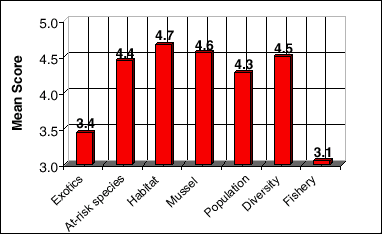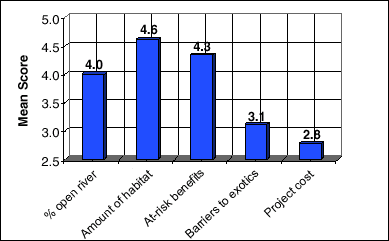|
PSR 2000-06 November 2000 Fish Passage as a Management Goal in the Upper Mississippi River: Results of a Recent Surveyby Brian S. Ickes |
|||||||||||||||||||||||||||||||||||||||||||||||||||||||||||||||||||||||||||||||||||||||||||||||||
|
Dams have had a large impact on the movements and migrations of fishes. Recent research suggests that the 27 low-head navigation dams in the Upper Mississippi River System (UMRS) can act as semi-barriers to fish migration. Several fish species that appear to be effected are considered endangered, threatened, or at-risk in the UMRS; these include pallid sturgeon, lake sturgeon, paddlefish, skipjack herring, blue sucker, goldeye, black redhorse, and yellow bass. Additionally, restricted fish passage may be a primary causal factor in the decline of several freshwater mussel species. Aside from a few well-documented case studies, however, the consequences of restricted fish passage in the UMRS are largely unknown. Scientists at the USGS Upper Midwest Environmental Sciences Center (UMESC), in cooperation with the U.S. Army Corps of Engineers and state resource management agencies, are attempting to define these consequences. We are presently conducting a critical review of the scientific literature to assess the consequences of restricted fish passage in the UMRS. To this end, we surveyed river managers, scientists, and administrators to identify specific management and scientific issues that reflect basin-wide fish passage concerns. This report summarizes results from that survey. Survey methods Survey content guidelines were provided by an eight-member review panel representing the greater UMRS management, scientific, and administrative community. The survey was compiled by UMESC scientists and subjected to review from the panel before submission to a wider respondent pool. The survey was administered over the internet, providing respondents the opportunity to complete it electronically or in hard copy form. The survey can be viewed at http://umesc.usgs.gov/surveys/fish_passage.html. The survey was posted on July 21, 2000, and respondents were given 3 weeks to respond. A pool of 96 survey respondents, comprised mostly of the Upper Mississippi River Conservation Committee Fisheries Technical Section, was selected to complete the survey. Results Eighteen responses were received, a 19% response rate. Scientists comprised 67% of the respondents, and managers and administrators each comprised 16.5% of the respondents. When asked the importance of improved fish passage as an aspect of ecosystem restoration, respondents felt that it was very important (mean score 4.7 on a 5-point scale). Of the seven concerns associated with restricted fish passage identified by the survey review panel, respondents reported habitat, mussels, community composition and diversity, endangered and threatened species, and fish population dynamics to be the most important (Figure 1). Concerns about exotic species and recre-ational or commercial fisheries were of lower concern. |
|||||||||||||||||||||||||||||||||||||||||||||||||||||||||||||||||||||||||||||||||||||||||||||||||
|
|||||||||||||||||||||||||||||||||||||||||||||||||||||||||||||||||||||||||||||||||||||||||||||||||
|
The most important considerations in prioritizing UMRS dams for fish passage improvements were the amount of critical or important aquatic habitat in neighboring pools and benefits to threatened and endangered species (Figure 2). Project cost and the spread of exotics were of lowest concern. |
|||||||||||||||||||||||||||||||||||||||||||||||||||||||||||||||||||||||||||||||||||||||||||||||||
|
|||||||||||||||||||||||||||||||||||||||||||||||||||||||||||||||||||||||||||||||||||||||||||||||||
|
Respondents were fairly certain that restricted passage has altered the geographic range, diversity, or community structure of UMRS fish species (89% agreed), that reduced fish passage had diminished access to spawning areas (78% agreed), and that reduced fish passage has affected the distribution of native freshwater mussel fauna (72% agreed) (Table 1). Respondents were much less certain of other suspected consequences of restricted passage. |
|||||||||||||||||||||||||||||||||||||||||||||||||||||||||||||||||||||||||||||||||||||||||||||||||
|
|||||||||||||||||||||||||||||||||||||||||||||||||||||||||||||||||||||||||||||||||||||||||||||||||
|
The type of information responses were based on varied widely. For example, peer reviewed sources were cited as the primary source of information for two of the seven questions asked, whereas personal opinion was the primary source for the other five questions (Table 1). Gray literature sources and expert opinion were less frequently cited as information sources. Summary As a management goal, respondents viewed fish passage as a very important component of ecosystem restoration. However, there is considerable uncertainty regarding the impacts UMRS dams have had on the river’s fish and mussel resources. Moreover, a theoretical foundation for determining ecological consequences of restricted fish passage in the UMRS has yet to emerge. Such a foundation is needed to develop applied approaches for mediating any realized impacts. Future research efforts will focus on reducing uncertainty and developing a theoretical framework for examining the ecological consequences of restricted fish passage in the UMRS. |
|||||||||||||||||||||||||||||||||||||||||||||||||||||||||||||||||||||||||||||||||||||||||||||||||
|
This report is a product of the Long Term Resource Monitoring Program for the Upper Mississippi River System. For further information, contact Brian S. Ickes Project Status Reports (PSRs) are preliminary documents whose purpose is to provide information on scientific activities. Because PSRs are only subject to internal peer review, they may not be cited. Use of trade names does not imply U.S. Government endorsement of commercial products. All Project Status Reports are accessible through the Upper Midwest Environmental Sciences Center’s website at http://umesc.usgs.gov/reports_publications/psrs/umesc_psr.html |
|||||||||||||||||||||||||||||||||||||||||||||||||||||||||||||||||||||||||||||||||||||||||||||||||
Page Last Modified: April 17, 2018



